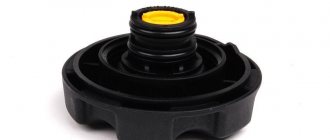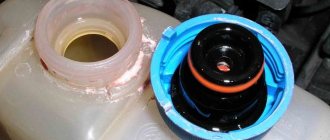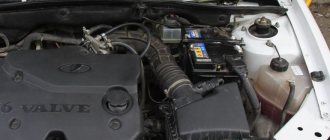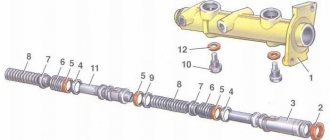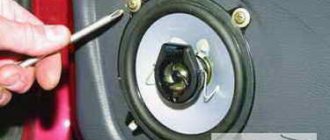Print this article Font size 16
In a VAZ 2114 car, the expansion tank serves to remove heat from the power unit. It is noteworthy that these devices have approximately the same design on all AvtoVAZ vehicles. The differences are quite minor.
Photo of the expansion tank on a VAZ 2114
Over time, this unit also needs to be replaced. Therefore, today we will talk in more detail about the expansion tank, its characteristic malfunctions and the method of replacement.
What is this?
Or rather, what he looks like. The expansion tank is a container made of plastic. Liquid is poured inside it, which takes part in cooling the motor.
In addition to the hoses that are connected into a circuit, the tank design also includes a float sensor. With its help, information about the temperature of this liquid is transmitted to the car’s instrument panel inside the cabin.
This unit is located under the hood, on the driver's side. You can easily find it right behind the glass counter. Such placement cannot be called practical, since there is metal on all sides of the tank. Therefore, the metal does not allow the plastic to expand properly if the reservoir cap does not work properly.
The result is the same - the container bursts. This problem is especially relevant in the summer, when the car heats up not only from the engine, but also from active sunlight.
Typical faults
It is important to note that the principle of operation of the expansion tank cap on the VAZ 2114 is based on the fact that it has a valve that allows you to relieve excess pressure when the power plant overheats.
Expansion tank cover
It is the lid that causes the most problems.
- The lid often gets stuck and jams, which is why the pressure builds up, but cannot come out of the tank. There were even cases when the tank exploded. If you encounter such a situation while driving, do not turn off the engine. You need to slow down and wait a while. The radiator fan should turn off on its own.
- The tank is directly connected to the radiator and its cooling fan. Therefore, it is sometimes recommended to check the entire cooling system and pay special attention to it in the summer.
- There may be a drop in the coolant level inside the reservoir. This indicates the need to check the container for cracks leading to leakage. Inspect the entire unit for even the smallest leaks.
- Pay special attention to drips on the neck. Such traces of liquid indicate that the valve is faulty.
Typical problems and their diagnosis
Common faults:
- Violation of the tightness of the tank: the tank begins to leak due to mechanical damage;
- Rupture of the container due to impact or technological defect.
- Problems with the reservoir cap.
Tank cap malfunctions need to be disassembled separately, as this is the most diverse and common group of breakdowns. A clogged cover valve most often causes inconvenience to owners of “fourteeners”. The valve “clogs” due to dirt and stops releasing hot air. This leads to multiple excesses of operating pressure and overheating of the motor.
Also, coolant may leak through the cap, causing the working fluid level to gradually decrease. A leak can be identified by the presence of smudges in the expansion tank.
Common signs of a broken expansion tank:
- traces of leaks on the tank body;
- The engine overheating indicator light is on;
- smoke from under the hood, other signs of significant overheating;
- warm air does not come out of the heating deflectors, despite the fact that there are “symptoms” of a significant increase in the operating temperature of the engine.
Is repair possible?
A very common question that we can answer without any problems.
Repairing the expansion tank is only relevant if it is necessary to replace one of its components. That is, a float or a lid with a valve.
In any other situation, when the breakdown is associated with loss of tightness of the tank, no repair will be possible. Some use adhesives, sealants, and other methods to close cracks. But such pseudo-repairs will not lead to anything good. All you need is a complete and complete replacement of the expansion tank of the VAZ 2114.
Procedure for replacing the tank
The replacement process will not cause any particular difficulties even for a novice car enthusiast, but, of course, there are some nuances that will be discussed. Replacing the expansion tank of a VAZ 2114 is carried out in several stages.
- Prepare tools and materials. A screwdriver, wrenches, pliers, sandpaper, car sealant are what you will definitely need.
- Allow the engine and antifreeze to cool before replacing. Then drain the coolant. You can drain the entire system or simply pump out excess fluid from the reservoir. The drain plug is located at the bottom of the radiator and can be easily unscrewed. Place a container under the drain to avoid spilling it on the floor or ground. If antifreeze needs to be replaced, drain it into a container with a capacity of at least 3-4 liters.
- Disconnect the hoses from the tank by loosening the clamps. Then remove the expansion tank support and remove it.
- Before installing a new expansion tank, it is recommended to sand the surface of the fittings on which the pipes are laid. Place the tank in its original position and fix it. Lubricate the fittings that have been cleaned of roughness with sealant. Automotive sealant should be used at high operating temperatures, usually red in color
- We put pipes on the treated fittings and tighten the seats with clamps. The clamps should be tightened as close to the fitting flare as possible and then wait for the sealant to cure.
- Fill the reservoir with coolant, new or the one that was drained before replacement. The fluid level must be brought to a minimum; it is determined by the division on the expansion tank itself. Install the level indicator with sensor and close the lid.
- We start the engine, wait until it warms up to operating temperature and turn on the radiator cooling fan. At this temperature, air will be removed from the system and the level of antifreeze in the tank should increase, which in turn will increase the pressure in the system and force the valve in the cap to operate. After turning off the fan, check the level in the tank; it should be at maximum. If necessary, add or remove excess antifreeze from the cooling system. The VAZ 2114 cabin has a graphic warning lamp that lights up when the antifreeze level is low. If the fluid level is visually normal, but the indicator does not go off, the float and sensor may need to be replaced. It is sold separately and is inexpensive.
- We inspect the connection points of the hoses and the tank lid. If there is no fluid leakage, the replacement is complete. It should be noted that it is necessary to carry out regular visual inspection of all visible elements of the engine cooling system.
Hoses and tubes wear out over time, lose flexibility, crack and may burst. They need to be replaced immediately. The pipe clamps may become loose, which will be indicated by the presence of moisture at the connection points.
I would also like to note that the coolant itself may lose its properties over time due to overheating or water entering the system. This can usually also be determined by inspection; the liquid changes color.
For those. According to the rules, the fluid must be changed every five years or 75,000 kilometers, whichever comes first. It is very important to know that antifreeze and antifreeze cannot be mixed, otherwise the liquid will lose its properties. When replacing the expansion tank, determine whether you need to replace it with all the elements or whether you can limit yourself to just the tank itself.
To avoid problems with the cooling system, it is necessary to follow all the manufacturer’s recommendations and regularly monitor the operation of units and sensors. When replacing parts, it is recommended not to skimp and use branded ones.
As is clear from the above text, if all rules and operating conditions of the vehicle are observed, replacement and repairs can be avoided for as long as possible. But if there is still a need to replace the expansion tank or its elements, thanks to our advice you can easily solve the problem yourself without contacting a service center.
Purchase of components
There are some helpful tips to follow when purchasing new parts to replace your expansion tank.
- Buy the original. The original tanks are ideal for the “fourteenth” AvtoVAZ model. Therefore, various analogues are inappropriate here. The level of quality and efficiency of the original is much higher.
- If a cover is required, then use the analogue from model 2199. They are fully compatible even with threads. Plus, the practice of VAZ 2114 owners shows that the “nine” cover works better than the original one.
Repair or replace the tank?
Some drivers, noticing that expansion tank 2114 is leaking, try to seal the gap with glue or epoxy resin.
It’s worth noting right away that it’s absolutely not worth it. After all, such repairs are usually short-lived, and with active use, even the most reliable adhesive seam can leak.
Also, as already mentioned, the appearance of cracks in the tank is a sign of aging of the plastic caused by depolymerization - the volatilization of a number of fractions from the material, giving it plasticity.
Therefore, plastic containers that have already broken can always break again. That is why replacing the VAZ 2114 expansion tank is the most preferable option than repair.
As for the cover, it also cannot be repaired and in case of malfunction must be replaced with a similar one. At the same time, it is highly advisable to purchase the “native” case for the 2114, and not its various analogues, the quality (and functionality) of which could be much worse.
If you can't find a case for the 14, you can buy and install a case for the 2199, as they are completely interchangeable.
Replacement nuances
The process of replacing the expansion tank is quite simple; it does not require extensive experience or any supernatural knowledge in the field of car repair. But certain recommendations are worth following.
- Arm yourself with all the necessary tools and materials at once. This includes sandpaper, keys, pliers, screwdrivers, clamps. Sandpaper is required to process the inlet holes, since they are rough from the factory. And they must be smooth so that the pipes fit as securely as possible.
- Follow the instructions that come with each new expansion tank. This is the most correct guide, so there is no amateur activity.
- If you have just arrived at the garage, wait a while for the car to cool down.
- After this, you can open the radiator cap to reduce the pressure inside the system.
- It would be a good idea to replace the coolant. To do this, first drain the old one. There is a plug at the bottom of the radiator, which can be unscrewed to drain the liquid.
- If the fluid is new, pinch the pipes while dismantling the old tank. This way you won't lose your fresh coolant.
- Do not tighten the clamps with too much force, as this may cause damage to the expansion tank inlet.
- Check the fluid level in the new container. Be sure to top up if necessary.
- The VAZ 2114 model is quite demanding in terms of maintaining an average liquid level inside the expansion tank with cooler.
- After completing the assembly, turn on the ignition and let the engine run until it reaches boiling temperature. After this, the fan located on the radiator should turn on. At this point, pay attention to the expansion tank cap. It should rise and release excess pressure.
- Look at the instrument panel. If the pressure release occurs, but the panel indicates a low fluid level, you will have to change the sensor in the tank. It can be purchased separately. Installation is very simple; it consists of disconnecting a special chip on the cover, from where the old sensor is unscrewed, and a new one is screwed in its place.
Obviously, changing the engine cooling system tank or replacing its individual valve is a fairly simple type of repair of the VAZ 2114, which definitely does not require contacting specialists from service stations.
But who did the repairs is not as important as how well the work was done. This is the basis for preserving engine life, as well as your personal safety on the road. Monitor the condition of the cooling system and carry out periodic diagnostics. If malfunctions are detected, determine whether it is necessary to change the entire expansion tank as a whole, or whether it will be enough to install a new cap. You already know how to perform both operations. Good luck!
Expansion tank VAZ 2114: main breakdowns
It would seem, what kind of damage can happen in a piece of plastic? But yes, they exist:
- Cracks appear on the body, from which liquid leaks.
- Violation of the integrity of the plug that regulates the pressure in the system.
- Destruction of the thread on the neck and other damage.
As for the plug, everything is banal - the valves are clogged and excessive pressure is not released. Associated symptoms - the tank swells and becomes like a ball.
The worst thing that can happen is the fluid bubbling in the tank. This is a clear sign that there is a breakdown in the cylinder head gasket. But this is a separate story, which will be discussed in one of the following articles. Sometimes air pockets appear in the system. In this case, the stove does not work well, therefore, heat exchange does not occur correctly. It’s easy to get rid of air pockets - install the cap on the tank and warm up the engine to operating temperature. To be sure, crimp the long pipes with your hands.


